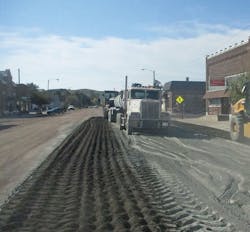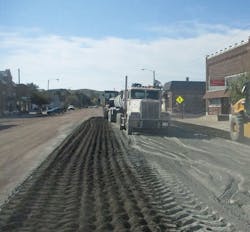The toughest armor
To settle the nerves he just kept making a fist.
After water was added to a mixture that included portland cement, the old asphalt that once formed Main Street (and its sub-base) in the village of Verdigre, Neb.,
Dale Bohac started following the padfoot roller on the job. Every few yards he would bend down and pick up a handful of the new mixture, and if he could ball it up the water/cement ratio was about on target.
“You can do all the math you want in the world, but you need to make it work in the field,” Bohac, a project engineer for JEO Consulting Group Inc., told Roads & Bridges. “So I just reached down and grabbed it, and if I opened up my hand and it all stuck together that meant I was getting enough water into the material.
“As you are going through there, the consistency of the dry material changed. I might have 2 in. of armor coat [tack] or asphalt and then go to nothing. Generally it was within reason but you always wanted to make sure you had water available for the cement to hydrate. “
For years, road funding for the village of Verdigre was dry. City Superintendent Willie Bosanek, who proudly drove around in an old Chevy pickup with personalized license plates that read POTHOLE, usually worked with a $30,000 per year preservation and maintenance budget. After neglecting the roads for nearly 25 years, city officials thought it was time to improve as much as possible and passed a bond. Now the question was what method to use, and after Village Chairperson Dave Wickett placed some calls the answer became obvious. Full-depth reclamation had been performed successfully across the region, and the village of Verdigre called on the team of JEO Consulting (Norfolk, Neb.), GSI (Grand Island, Neb.), Coughlin Co. (Salina, Kan.), and Sta-bilt (Harlan, Iowa) to handle the work that began Sept. 26 and took just seven days to complete.
“They would like to do more [full-depth reclamation], but a lot of these towns are in the same position,” said Bohac. “They only have so much they can afford to put towards the streets out of their general budget. In this area, people are pretty conservative. They are not going to go out and borrow a bunch of money and then figure out how to pay it back later.”
The village of Verdigre was able to cover 17 of its 66 blocks, or just over 25%, at a cost of $347,500. Typical reconstruction of the roadway with hot-mix asphalt would have cost about $650,000, so in the end the village saved just over $300,000, and claimed a 2017 Roads & Bridges/Asphalt Reclaiming and Recycling Association Recycling Award.
“It is the best use of funds they could do to improve these deteriorating streets, because if you asphalt-overlay three or four blocks what do you gain?” said Bohac. “You are really not touching the town, so we were able to take this money and paint a pretty broad footprint and improve the main streets.”
The project consisted of 31,000 sq yd of debilitated roadways identified for reclamation.
Getting it done
Surveys performed by JEO of the existing road found the existing asphalt layer in very poor condition. According to Bohac, the sub-base had deteriorated to a point that an asphalt overlay would not last very long. Potholes and alligator cracking infested the routes in, out and around town. Years worth of tack coat made conditions even worse. Main Street also carried a heavy amount of truck traffic, as it serves as the only route in and out of town.
“A lot of towns in this area armor coat one-fourth of their streets every year, and you just keep building that up and up and you really don’t fix what is underneath,” claimed Bohac.
The project consisted of 31,000 sq yd of debilitated roadways, including Main Street, identified for reclamation. The FDR mix, provided by GSI, used 6% portland cement as the stabilizing agent, 40% reclaimed asphalt pavement (3 in. thick) and 60% (5 in. thick) of the existing road base. The mix of materials provided the structure in the base course and then a chip seal was added to serve as the final wearing surface.
Pulverizing the existing streets began on Sept. 28, 2016. In order to maintain curb reveal and match the road profile, a Caterpillar RM 500 Reclaimer was used to do the initial work which began on the outside edge of the roadway. This required two passes, then a Komatsu GD 655 motor grader windrowed the material, and some of the material was loaded into dump trucks and hauled away. A cement spreader truck equipped with a 28-ton hopper and automatic controls was used to accurately measure the cement application rate of 6% by dry weight, or about 121.5 lb per cu ft. A 3,000-gal tandem axle water truck added water to activate the portland cement and bring the optimum soil moisture content to 8.4%. Once the portland cement was mixed in with the old asphalt and sub-base by the Cat RM 500, a Caterpillar 562 padfoot roller and an Ingersoll Rand pneumatic tire roller followed. The target compacted density of the reclaimed material was 126 lb per sq in. The goal was to achieve 300-400 psi unconfined compressive strength in seven days.
In between the pad foot roller and pneumatic tire roller, an operator working the Komatsu motor grader would come in and create a 2% crown for the road profile . . . all by feel and sight. He did not use any type of GPS technology or string line.
If maintained properly, Bohac believes the village could get 10 years or more out of the FDR project.
“It takes somebody that has run a machine quite a few years to be able to do that,” remarked Bohac. “He was doing it all manually. At first I thought he was unfriendly, but then I realized he was paying attention to what he was doing. He was just doing it by touch, by feel of the controls.”
The chip seal was applied by Sta-bilt a few days after the road had cured to an acceptable moisture content. Sta-bilt used ED Etnyre 4,000-gal chip spreaders. The compaction of the roadway was completed with two Ferguson pneumatic tire rollers. A Troxler nuclear gauge was used to check for density, which fell within a 98-100% range.
If maintained properly, Bohac believes the village could get 10 years or more out of the FDR project. The first real test is going on right now during the winter months.
“I want to see it go through a freeze-thaw and check it in April and May when there is some warm rain to tell us the whole story,” said Bohac. “When I first came into this I told them we were not giving them the Yellow Brick Road, but we were going to make it better.”


